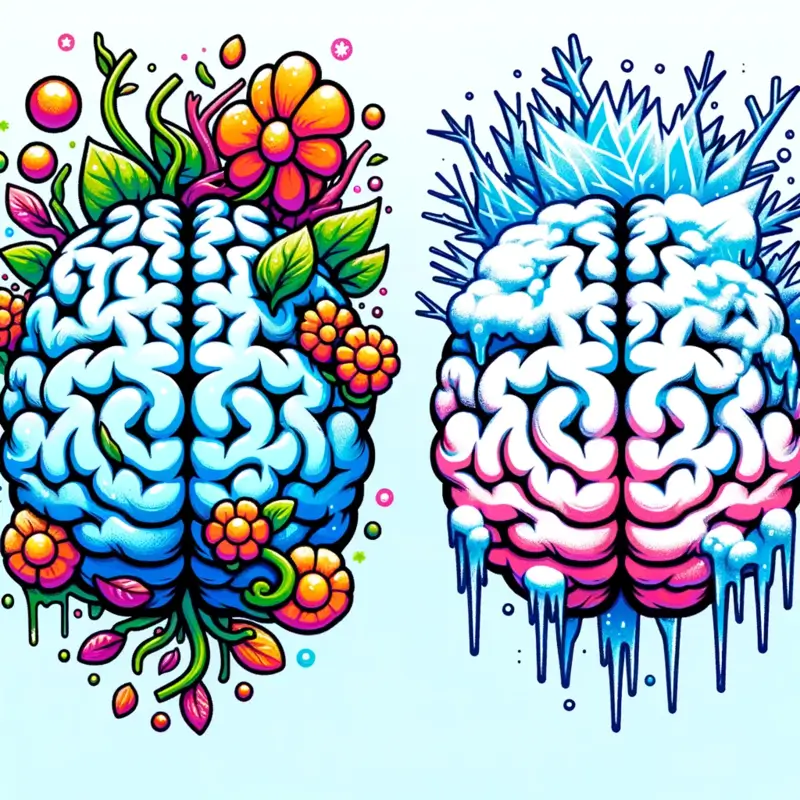Do you ever wish your team members embraced challenges with more enthusiasm and took setbacks as learning opportunities? That’s the power of a growth mindset.
When employees focus on continuous improvement and skill development, your whole team benefits. Research consistently shows that a growth-oriented workplace boosts motivation, performance, and innovation.
But how do you actually foster this type of mindset in your team? The key is in on the growth mindset activities for employees. They’re designed to push employees out of their comfort zones and reframe failures as stepping stones can pave the way for amazing transformation.
Ready to see what a growth mindset can do for your team? Let’s dive into some powerful activities you can implement right away!
Growth Mindset Activities for Employees
Growth doesn’t happen by accident, especially in the workplace. Cultivating a growth mindset in your team means providing them with targeted skill-building opportunities.
"The greatest discovery of all time is that a person can change by merely changing his attitude."
 Oprah Winfrey
Oprah Winfrey With regular practice and the right support, everyone can improve – your top performers and those needing a bit more guidance. Here are some activities to get you started:
Skill Development
Expanding skillsets builds confidence, increases adaptability, and promotes a future-focused workforce. These activities encourage targeted skill-building and create a culture where learning is ongoing.
- Cross-Training: Have team members shadow colleagues in different departments for a day or two. This firsthand exposure expands their understanding of the bigger picture and helps them pick up new skills.
- ”Lunch and Learn” Sessions: Invite employees to host short lunchtime workshops on their areas of expertise. These offer low-pressure, in-house learning opportunities for everyone.
- Skill-Building Challenges: Gamify development with skill-focused challenges and rewards. For example, set a team goal for proficiency in a new software and recognize them for their progress.
- Mentor Programs: Pair more experienced employees with those looking to gain specific skills. Mentorship offers not only knowledge transfer but also builds connections and confidence.
- Online Courses and Microlearning: Supplement in-person activities with curated online courses, webinars, or microlearning resources. Encourage employees to choose topics that align with their development goals.
- Stretch Assignments: Offer up projects slightly beyond employees’ current capabilities. This provides a safe space to experiment, tackle new challenges, and receive support and feedback in the process.
- Role-Playing Exercises: Simulate real-world customer interactions or difficult conversations. This lets employees practice skills in a supportive environment before stepping into a real-life situation.
- ”Skills Swap” Days: Set aside a day or afternoon where team members volunteer to teach each other specific skills. This promotes a dynamic, peer-to-peer learning environment.
- Professional Development Funds: Provide designated funds for employees to pursue further education or training in areas of interest. This signals your commitment to their growth.
- Feedback Loops: Normalize asking for feedback and make it constructive. Create an environment where employees are comfortable pointing out strengths and areas for improvement in a respectful way.

Problem-Solving
The workplace is full of unexpected challenges. Employees who approach hurdles with a “can-do” attitude and creative thinking skills become invaluable assets.
These activities boost problem-solving prowess and help employees embrace obstacles as opportunities to learn.
- Open-Ended Brainstorming: When faced with a problem, facilitate a judgment-free idea session. Encourage wild suggestions and put emphasis on quantity over immediate quality. This helps break down mental barriers and pave the way for innovative solutions.
- Root Cause Analysis: Guide employees to dig deeper into the “why” behind a problem, often using tools like the “5 Whys” technique. This prevents simple surface-level fixes and leads to more lasting solutions.
- ”Failure” Case Studies: Examine famous mistakes or setbacks by companies or individuals. Discuss what lessons can be learned and how those insights could be applied to your team’s work.
- Design Thinking Challenges: Introduce your team to the design thinking process – empathize, define, ideate, prototype, test. Present them with a real or hypothetical problem to tackle using this structured approach.
- Real-World Simulations: Create mini-crisis scenarios, such as a client dispute or an unexpected deadline change. Observe how your team reacts and offer feedback focused on a growth mindset perspective.
- Reverse Brainstorming: Give your team a problem, but instead of solutions, have them brainstorm ways to make things worse! This forces them to think creatively and break free from standard thought patterns.
- The “Worst Idea” Pitch: Ask team members to come up with the absolute WORST possible solution to a problem. This can spark laughter, relieve pressure, and sometimes even lead to surprisingly useful insights by identifying what to avoid.
- Resource Constraint Challenges: Present a problem and limitations (budget, time, etc.). This forces teams to think outside the box and prioritize creatively.
- Role Reversal: Have team members step into the shoes of customers, clients, or stakeholders when confronting issues. This builds empathy and may generate entirely new perspectives on solutions.
- Ask The Expert: Occasionally invite an outside expert (from another department or industry) for a fresh viewpoint. An outsider’s lack of preconceptions can help uncover new options and approaches.
Collaboration
Strong teams don’t just happen – they’re built on trust, respect, and the ability to leverage collective strengths.
In a growth mindset workplace, collaboration becomes a source of innovation and improvement. Help your team work together better with these activities:
- Cross-Functional Projects: Assemble teams with diverse skills and backgrounds to tackle problems that cross departmental lines. This encourages communication, understanding, and appreciation for different skillsets.
- ”Constructive Criticism” Sessions: Schedule sessions where team members provide specific, actionable feedback on each other’s work. Train people to frame feedback positively and focus on opportunities for improvement.
- Shared Team Goals: Establish goals that can only be achieved with collaboration. This builds interdependence and reinforces the idea that everyone’s contributions matter.
- Co-Creation Workshops: Task teams with designing new products, processes, or strategies together from the ground up. This values everyone’s input and helps build a sense of shared ownership.
- Team Appreciation Activities: Take time to celebrate teamwork wins, small and large. Recognizing moments of successful collaboration can reinforce positive behaviors and build a feel-good factor.
- Peer Teaching: Encourage team members to lead short educational sessions where they share their knowledge on specific topics, tools, or workflows. This promotes knowledge-sharing and positions teammates as valuable resources for one another.
- Rotating Facilitators: Instead of one designated leader, have team members take turns leading meetings or project phases. This promotes shared responsibility and helps different leadership styles emerge.
- Interdepartmental Networking Events: Set up informal get-togethers with teams from different areas of the company. This breaks down siloes, forges connections, and can spark unexpected collaborative ideas.
- Conflict Resolution Training: Offer training that addresses healthy conflict resolution within teams. Teach methods for active listening, finding common ground, and navigating disagreements productively.
- Appreciation Boards: Set up a physical or digital space where team members can easily give shout-outs to teammates who’ve been helpful, supportive, or demonstrated good collaboration skills. This creates a positive feedback loop and highlights desired behaviors.
Innovation
Innovation stems from an environment where experimentation and even calculated risks are encouraged. It’s about giving your team the psychological safety to step outside their comfort zones and challenge the status quo.
Here’s how to spark that innovative spirit:
- Ideation Jams: Schedule dedicated times for rapid brainstorming around specific problems or opportunities. Set clear parameters, keep it fast-paced, and emphasize generating as many ideas as possible, without judgment.
- ”Hackathons”: Host internal events where teams compete to develop new solutions, prototypes, or process improvements within a specified timeframe. This gamifies innovation and provides focused time for experimentation.
- Trend Research Assignments: Give employees time to research cutting-edge trends in your industry or beyond. Use their findings to brainstorm how emerging technologies or ideas might reshape your company’s work
- ”What If…” Discussions: Start meetings or workshops with a hypothetical “What If…” scenario that forces everyone to think creatively and envision new possibilities.
- Failure Awards: Establish a fun ritual to celebrate “good failures” – experiments that didn’t go as planned but yielded valuable lessons. This de-stigmatizes risk-taking and emphasizes learning.
- Reverse Engineering: Give teams successful products or services from competitors or adjacent industries. Task them with dismantling how they work, what the advantages are, and how the idea could be reimagined for your own company.
- Innovation Spotlight: Dedicate a section of team meetings to highlighting an innovative company or breakthrough. Discuss their successes and generate ideas on how to bring similar out-of-the-box thinking to your own work.
- Customer Feedback Ideation: Collect direct feedback from customers or clients on pain points or desired improvements. Use this as a springboard for a brainstorming session where teams pitch solutions tailored to this real-world input.
- Innovation Incubator: If resources allow, carve out a designated space or time for employees to brainstorm and tinker with new ideas. Provide the necessary tools and a ‘greenhouse’ environment where risks are encouraged.
- Cross-Industry Inspiration Trips: Send team members on visits to companies in entirely different industries. Observing how problems are solved in unusual contexts can inspire fresh approaches back at your workplace.
Adaptability
In today’s rapidly changing workplace, the ability to handle unexpected shifts and pivot gracefully is essential. Fostering adaptability in your team keeps them agile, reduces stress, and helps them thrive in the face of ambiguity.
Try these activities to build those flexible mindsets:
- Scenario Training: Present hypothetical scenarios your team might encounter, like sudden project changes or shifts in client needs. Have them brainstorm responses in real-time, focusing on staying calm and thinking through adjustments.
- Ambiguity Challenges Give your team projects with limited instructions or deliberately vague goals. This forces them to get comfortable with uncertainty, prioritize problem-solving, and remain flexible in their approach.
- Job Swaps: Encourage short-term “swaps” where employees trade roles within a team or even with colleagues in other departments. Experiencing work from another viewpoint enhances understanding and cultivates flexibility.
- Process Feedback Workshops: Task employees with examining a standard process and identifying areas for improvement or streamlining. This promotes a ‘change readiness’ mindset where processes are continuously evaluated for efficiency.
- Mindfulness Practice: Simple mindfulness exercises like guided meditations or breathing techniques can be incorporated as part of the workday. This builds the ability to stay grounded in the moment and reduce stress when faced with sudden changes.
- ”Plan B” Meetings: During project planning, dedicate time to brainstorm potential roadblocks and create contingency plans. This gets teams thinking proactively and ensures that surprises don’t derail them completely.
- Change Champions: Identify employees who naturally approach change with positivity. Let them lead “lunch and learn” sessions sharing that attitude, or act as mentors to those needing extra support during adjustment periods.
- Agile Methodologies: If relevant to your work, introduce your team to agile principles (like Scrum). Their focus on constant feedback cycles and iteration builds adaptability by making change part of the routine.
- Celebrate the Pivot: Highlight successful instances where teams have swiftly adapted to changes or adjusted their course mid-project. Celebrate wins that emerged from this flexibility.
- Post-Project Reflections: Build in time for a “lessons learned” review after completing projects. Discuss not just outcomes, but how the team handled disruptions and what can be improved for the future.
Leadership
Great leaders possess a unique blend of technical skills, emotional intelligence, and an innate belief in their ability to grow and inspire others.

These activities are designed to enhance those leadership qualities while promoting a growth mindset amongst managers and rising stars alike.
- Mentorship Programs (Two-Way): Pairing seasoned leaders with newer ones benefits both parties. Senior leaders benefit from new perspectives, while rising stars gain support. In a growth mindset version, encourage both to identify areas for their own development, not just one-directional feedback.
- ”Failure Resume” Exercise: Leaders share a ‘resume’ documenting missteps in their career, focusing on lessons learned. This creates vulnerability and combats the misconception of perfection at the top.
- Leadership Book Club: Select a book on leadership styles, communication, or a new methodology. Engage in facilitated discussions to apply ideas directly to your workplace.
- Empathy-Focused Training: Offer role-playing exercises, perspective-taking workshops, or client engagement training to hone emotional intelligence and cultivate understanding of different viewpoints.
- Visioning Workshops: Task leaders with defining and presenting their personal vision for your team or department. This promotes ownership, forward-thinking, and empowers employees to become proactive stakeholders in the bigger picture.
- 360-Degree Feedback: Implement a structured feedback system where leaders receive evaluations from their superiors, peers, direct reports, and even clients (if applicable). Emphasize identifying both strengths and areas ripe for further development.
- Leadership Shadowing: Offer opportunities for aspiring leaders to shadow more experienced managers for a day or two. This provides firsthand experience and a safe space to observe decision-making, communication styles, and conflict resolution in action.
- Coaching Sessions: Provide targeted coaching or sponsor external coaches for leaders. This offers focused, confidential support while addressing specific growth goals or challenges.
- Stretch Leadership Assignments: Offer new or ambitious projects that push leaders slightly outside of their comfort zone. This builds confidence and gives them practice applying growth mindset principles to challenges in the real world.
- Growth-Focused Performance Reviews: Shift the focus away from purely outcome-driven reviews. Prioritize discussions about skill acquisition, effort, and lessons learned throughout the year from both wins and struggles.
Understanding a Growth Mindset in Employees
Before trying to change mindset, let’s take a deeper look at what growth mindset actually means for your employees.
Here, we’ll explore why understanding this concept is key to implementing workplace programs, what benefits it yields, and the difference between a growth and fixed mindset.
Importance of Having a Growth Mindset
A growth mindset isn’t just a feel-good buzzword. It has real-world consequences within your workplace. Let’s break down why fostering this outlook in your employees is so crucial:
- Embracing Challenges: With a growth mindset, employees view challenges as stepping stones, not roadblocks. This creates a proactive and solution-oriented workforce rather than one paralyzed by fear of failure.
- Resilience and Grit: Setbacks are inevitable, but employees with a growth mindset bounce back faster. They see failures as temporary and focus on what they can learn to do better next time.
- Increased Motivation and Performance: Research consistently shows that individuals with a growth mindset are more motivated, persistent, and ultimately, more successful. It drives a continuous loop of self-improvement.
- Improved Team Dynamics: Growth mindsets create a collaborative environment where employees celebrate each other’s successes and offer support during struggles. This builds trust and a sense of shared purpose.
- Innovation and Adaptability: When employees aren’t afraid to step outside the box and try new things, innovation flourishes. Likewise, growth mindset teams are better equipped to navigate change and uncertainty.
Benefits of a Growth Mindset
A growth mindset isn’t just beneficial for the company – there are powerful ways it transforms and improves the lives of your employees:
- Enhanced Learning and Skill Acquisition: Individuals with a growth mindset actively seek out new information and knowledge. They understand their potential isn’t set in stone and embrace challenges as opportunities to learn and expand their skill set.
- Greater Career Success: Studies show that growth-minded employees enjoy greater career advancement and increased earning potential. Their willingness to learn, resilience, and adaptability make them highly valued by employers.
- Stronger Relationships: Those embracing a growth mindset tend to approach conflicts and collaboration with greater empathy. They take ownership of their role in misunderstandings and focus on positive outcomes, forming stronger interpersonal connections within their team.
- Reduced Stress and Burnout: Having a growth mindset creates a greater sense of control and reduces self-limiting beliefs. Employees no longer feel powerless in the face of challenges, minimizing stress and increasing job satisfaction.
- Overall Happiness and Well-being: Individuals with a growth mindset are generally happier and more fulfilled. They believe their abilities are in constant development, encouraging self-acceptance and leading to greater self-confidence.
Difference between Growth and Fixed Mindsets
| Characteristic | Growth Mindset | Fixed Mindset |
|---|---|---|
| Beliefs about Ability | Believe intelligence and talent can be developed. | Believe intelligence and talent are innate and unchangeable. |
| Focus | Focused on learning and improvement. | Focused on proving their abilities and avoiding appearing incompetent. |
| Response to Challenges | See challenges as opportunities to learn. | See challenges as threats and avoid them. |
| Response to Setbacks | View setbacks as feedback and opportunities to grow. | View setbacks as personal failures that confirm their lack of ability. |
| Effort | Value effort and see it as a path to mastery. | See effort as fruitless if innate talent is lacking. |
| Feedback | Actively seek out feedback and use it to improve. | Avoid or become defensive in the face of criticism. |
"Whether you think you can, or you think you can’t – you’re right."
 Henry Ford
Henry Ford Strategies and Obstacles in Growth Mindset Activities
Building a workplace powered by growth isn’t a one-off workshop – it requires ongoing effort and an awareness of challenges that may occur along the way.
Here, we’ll discuss key strategies to make your initiatives stick and potential stumbling blocks to be aware of:
Strategies
- Leadership Buy-In: For a company-wide mindset change, it’s essential that leaders visibly adopt growth mindsets themselves. Employees learn by example – seeing managers ask for feedback, take on challenges, and learn from mistakes is infinitely more powerful than a generic memo.
- Celebrate the Process, Not Just Results: Rewarding the pursuit of learning, even if perfection isn’t achieved, sends a strong message about what behavior is valued. Emphasize effort, willingness to experiment, and collaboration alongside project outcomes.
- Embed into Existing Systems: Don’t make growth mindset a separate ‘thing’. Weave it into performance reviews, goal setting, and professional development planning. This emphasizes that growing and improving is core to every employee’s work.
- Normalize Feedback and Failure: Create a culture where feedback is ongoing and constructive. This might involve training on delivering feedback or building in space for honest post-project reviews. Emphasize failures as valuable learning, not a reason to blame or shame.
- Consistency is Key: Developing a growth mindset isn’t a one-time intervention. Make growth mindset activities a regular part of your culture – whether through small initiatives throughout the year or focused, recurring development days.

Obstacles
- Resistance to Change: Some employees may cling tightly to old ways of thinking, seeing a growth mindset as extra work or “fluff.” Be prepared for initial skepticism or pushback.
- Fear of Failure: In environments where mistakes have been punished, people may be reluctant to take risks or step outside their comfort zone. Building a truly ‘safe’ environment for trying and failing takes time and repeated actions proving it’s truly safe.
- Time and Resource Constraints: Growth mindset activities often require additional time and resources for proper planning and implementation. Managers may feel squeezed between these efforts and regular workload demands.
- Cynicism or ‘Flavor of the Month’ Mindset:” Employees who have seen numerous initiatives come and go may initially approach mindset training with jaded eyes. This is where consistency and follow-through from leadership make a huge difference.
- Difficulty Measuring Mindset: Unlike performance metrics, tracking actual “growth mindset” progress can be a challenge. It’s often a subtler shift in perspective that manifests in attitudes and behaviors over time.
Don’t let these obstacles discourage you! Acknowledge them, talk about them with your team, and brainstorm ways to create systems that address them.
Quiz Time!
Frequently Asked Questions
Can anyone develop a growth mindset?
Absolutely! While some people may be naturally more growth-oriented, a growth mindset is a skill that can be learned and practiced. With the right resources and support, anyone can shift their thinking.
How long does it take to see the benefits of a growth mindset in the workplace?
It’s an ongoing process! You might notice immediate, small shifts in attitude. However, significant cultural transformation often takes months or even years, requiring dedication from both leadership and individual employees.
What can I do if my manager doesn’t have a growth mindset?
Focus on what you can control – your own attitude and actions. Model a growth mindset in your work and interactions with colleagues.
It’s possible your positive approach could be contagious! If appropriate, you can also try open conversations with your manager, expressing your interest in development opportunities or framing feedback using growth-oriented language.
Are there any books or resources to learn more about growth mindset?
Yes! We created an article about the best mindset books, you can take a look at it below on related articles. You can also find countless articles, TED Talks, and online courses exploring growth mindset concepts in more depth.
How can I encourage a growth mindset in my children?
Focus on praising effort and persistence rather than simply innate talent. Help them reframe challenges as learning opportunities and celebrate mistakes as a valuable part of the growth process.




